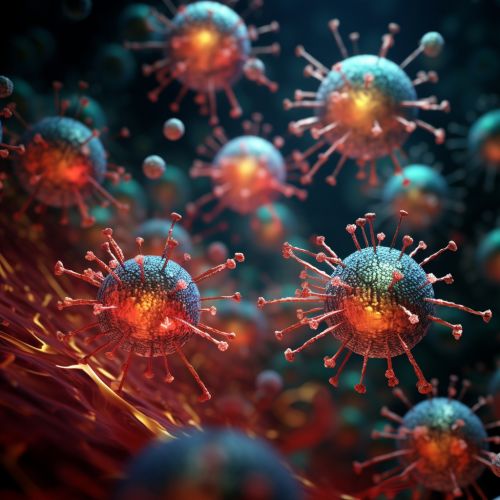Dengue virus
Introduction
Dengue virus is a member of the flavivirus genus in the family Flaviviridae. It is an arbovirus, which are viruses transmitted by arthropods, specifically mosquitoes in this case. Dengue virus is the causative agent of dengue fever, a significant public health issue in many tropical and subtropical regions of the world.


Virology
Classification and Structure
Dengue virus belongs to the genus Flavivirus, a group of positive-sense, single-stranded RNA viruses. There are four distinct serotypes of the virus, referred to as DENV-1, DENV-2, DENV-3, and DENV-4. Each serotype is genetically and antigenically distinct. The virus is enveloped and spherical in shape, with a diameter of approximately 50 nanometers.
Genome
The genome of the dengue virus is approximately 11 kilobases in length. It encodes a single polyprotein that is cleaved by host and viral proteases into three structural proteins (C, prM/M, and E) and seven non-structural proteins (NS1, NS2A, NS2B, NS3, NS4A, NS4B, and NS5). The structural proteins form the virus particle, while the non-structural proteins are involved in replication of the virus.
Replication Cycle
The replication cycle of the dengue virus begins with the binding of the virus to a receptor on the surface of a susceptible cell. This is followed by endocytosis of the virus into the cell and uncoating of the viral genome. The viral RNA is then translated into a polyprotein, which is cleaved into individual proteins. The viral RNA is replicated, and new virus particles are assembled and released from the cell.
Epidemiology
Dengue virus is transmitted to humans through the bite of infected female mosquitoes, primarily of the species Aedes aegypti and Aedes albopictus. These mosquitoes are widely distributed in tropical and subtropical regions around the world. The virus can also be transmitted from mother to child during pregnancy or at birth.
The incidence of dengue fever has increased dramatically in recent decades, with an estimated 390 million dengue infections occurring worldwide each year. The disease is now endemic in more than 100 countries, with the greatest risk in Southeast Asia, the Western Pacific, and the Americas.
Clinical Manifestations
Infection with dengue virus can result in a wide range of clinical manifestations, from asymptomatic infection to severe and potentially fatal disease. The most common clinical syndrome is dengue fever, a self-limited illness characterized by high fever, severe headache, pain behind the eyes, joint and muscle pain, rash, and mild bleeding.
A small proportion of individuals with dengue fever may progress to severe dengue, also known as dengue hemorrhagic fever or dengue shock syndrome. This is a life-threatening condition characterized by plasma leakage, fluid accumulation, respiratory distress, severe bleeding, and organ impairment.
Diagnosis and Treatment
Diagnosis of dengue virus infection is primarily based on clinical symptoms and epidemiological factors, such as travel to an endemic area. Laboratory confirmation can be obtained through a variety of methods, including virus isolation, detection of viral RNA by polymerase chain reaction (PCR), and serological testing for dengue-specific antibodies.
There is no specific antiviral treatment for dengue virus infection. Management of the disease is primarily supportive, with emphasis on hydration and management of symptoms. Hospitalization may be required for severe cases.
Prevention and Control
Prevention and control of dengue virus infection primarily involve vector control measures to reduce the population of Aedes mosquitoes. This includes elimination of mosquito breeding sites, use of insecticides, and personal protection measures such as use of repellents and bed nets.
A vaccine for dengue virus, known as Dengvaxia, has been developed and is licensed in several countries. However, its use is controversial due to concerns about safety and efficacy, particularly in individuals who have not been previously exposed to the virus.
